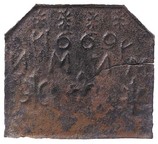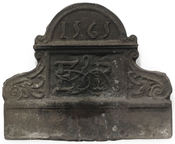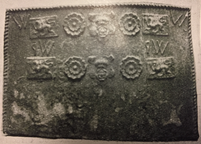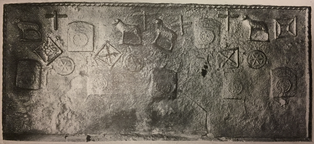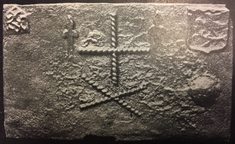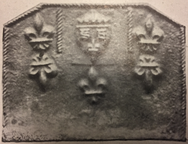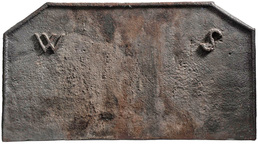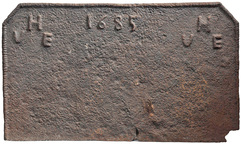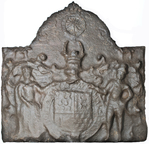-
845
Description: Canted rectangle; ovolo-moulded edging (top and sides); from top: double star stamp repeated four times; date between two triads of the same initials, the 'Y' and the 'N' reversed; stylised fleur-de-lys below each pair of initials, with a large hollow fleur-de-lys in the centre.
Notes: The initials 'NYM' in triad probably relate to a couple whose surname initial was 'Y'; a fireback, dated 1659, with some of the same stamps is at the Dean Heritage Centre, Soudley, Gloucestershire, and another, dated 1667, has been noted at Upper End Farm, Hope Mansell, Herefordshire. Christie's auction, 24 May 2001.
Inscription: NYM [triad] 1669 NYM [triad]
- Decoration tags:
- rectangular with canted top corners (shape)
- ovolo (edging)
- carved stamps
- individual letters
- individual numbers
- heraldic
- text
Manufactured: in 1669 in the Forest of Dean area of England.
Current location: not known.
- Attached to series:
- Date & initials firebacks
- Hollow fleur Dean series
- Newent area group
-
262
Description: Rectangular; twisted rope edging (top and sides); top centre, crowned Tudor royal shield (over-pressed) between a leopard passant guardant sinister (on the left) and a leopard passant (on the right); below, crowned shield bearing initials, KH, above a fleur-de-lys, between two crowned roses; below each leopard, a pair of 'imp' figures, the left of each with both arms lowered, the right its right arm raised; right top corner, a crowned rose; left top corner, and uncrowned rose.
Notes: One of the 'Royal' series. Christie's Interiors - Oak Edition, South Kensington (Sale 5369), 4 November 2008, lot 257 (£3,250).
Inscription: KH
Arms: Tudor Royal (prob. Henry VIII)
- Decoration tags:
- rectangular (shape)
- rope (edging)
- carved stamps
- heraldic
- armorial
- royal
- text
- animals
- objects
Manufactured: in the mid-16th century in the Weald area of England.
Current location: not known.
- Attached to series:
- Royal series
-
261
Description: Plain rectangular bottom panel with fillet on top; above, rectangular panel with fillet and ovolo-moulded edging, within which the initials, ER, ornately carved, intertwined with floral tendrils; on each side, a scrolled bracket with double fillet edging, enclosing [?] ears of corn; on top, a narrow cornich, with an arch above, scrolled at each end and with double fillet edging, enclosing the date, possibly formed of individual stamped letters.
Notes: The 'ER' initials should not be assumed to be those of Elizabeth I. Formerly at Ockwells Manor, Cox Green, Berkshire. Christie's auction 4 Nov 2008 lot 259 (£3,750).
Copies of this fireback are known.
Inscription: 1565 / ER
- Decoration tags:
- rectangular with round arch (shape)
- complex individual (edging)
- whole carved pattern
- individual numbers
- text
- plants
Manufactured: in 1565 in the Weald area of England.
Current location: not known.
- Attached to series:
- Personal firebacks
- Date & initials firebacks
-
1196
Description: Quasi-rectangular shape; twisted rope edging (top and sides); 'W' in top corners, between which are a line of five stamps: a 'renaissance' style shield bearing a rose and crown, between two rose stamps, and a rectangular stamp bearing a griffin at each end; below each dragon stamp, a 'W' preceded by a reversed 'P'; below this, the line of five stamps repeated.
Notes: The shield and griffin stamps have been seen on other firebacks, associating them with a common producer; the 'W' may be apotropaic and symbolic of the Virgin Mary. Illustration from Christy 1908 who noted the fireback at Guildford, Surrey.
Inscription: W W / qW qW
- Decoration tags:
- rectangular (shape)
- rope (edging)
- simple stamps
- carved stamps
- individual letters
- heraldic
- apotropaic
- animals
Manufactured: in the mid- to late-16th century in the Weald area of England.
Current location: not known.
- Attached to series:
- Griffin series
-
1194
Description: Rectangular shape; twisted rope or strap edging (top and sides); semi-random arrangement of three stamps interspersed with rope crosses and rope 'squares' with saltires or linked smaller squares within; low centre, a crowned rose-en-soleil stamp repeated, more or less regularly, five times across the width of the fireback; above, four circular butter mould stamps with a hexagonal design, between which are two rope squares with saltires and, to the left, a rope square containing a smaller square with its corners linked to the corners of the outer square; above, a horned sheep standing on a base repeated four times, between which are two crowned rose-en-soleil stamps and four rope crosses, with a square-within-a-square at the right end.
Notes: The rose-en-soleil was the badge of King Edward IV and, thus, a Yorkist symbol. It, together with the butter mould and rope squares, are seen on other firebacks associating them with the same producer/foundry. A ram is the crest of the Gage family of West Firle, for many centuries major landholders in Sussex; it is also the crest of the Clothworkers' Company of London. Formerly at Heringdales/Heronsdale Manor, Waldron, East Sussex, which, however, was not a Gage property. Illustration from Christy 1908.
- Decoration tags:
- rectangular (shape)
- rope (edging)
- simple stamps
- carved stamps
- heraldic
- apotropaic
- animals
- objects
Manufactured: in the mid- to late-16th century possibly at Pounsley Furnace, Framfield in the Weald area of England.
Current location: Wickham Manor, Winchelsea, East Sussex, England.
Museum number: NT/WMF/M/007 (part of the National Trust museum group)
Citation: Gardner, J. S., 1898, 'Iron Casting in the Weald', Archaeologia, 56, 1, pp. 133-164.
- Attached to series:
- Pounsley series
- Food mould stamp firebacks
- Rose-en-soleil series
-
1195
Description: Rectangular shape; no edging; top centre, cross formed of two lengths of twisted rope, with a flattened saltire of the same below; top right, a shield, indented at the top, charged with a bird upon a branch, below which is an indeterminate semi-spherical feature; on each side of the cross, a stylised fleur-de-lys in low relief; top left, an inverted shield with indeterminate decoration (suggested by Christy to be IC).
Notes: The cross and saltire will have had an apotropaic purpose. Illustration from Christy 1908, who stated it was in Buxted, East Sussex.
- Decoration tags:
- rectangular (shape)
- none (edging)
- simple stamps
- carved stamps
- heraldic
- apotropaic
- objects
Manufactured: in the early- to mid-16th century in the Weald area of England.
Current location: not known.
- Attached to series:
- Bird shield series
- Rope design firebacks
-
1197
Description: Canted rectangular shape; twisted rope edging (top and sides); top centre, over-pressed crowned shield stamp on a rectangular block, bearing initials KH in Lombardic lettering, above a fleur de lys, the whole between two short vertical lengths of twisted rope, on the outside of each are two fleurs-de-lys, vertically aligned, the lower ones inverted; below the shield, a fifth fleur-de-lys.
Notes: An arrangement of stamps found on a distinctive series of Tudor firebacks of probable Henrician date. Illustration from Christy 1908, who noted it at Riverhall, Wadhurst, Sussex.
- Decoration tags:
- rectangular with canted top corners (shape)
- rope (edging)
- carved stamps
- heraldic
Manufactured: in the mid-16th century in the Weald area of England.
Current location: not known.
- Attached to series:
- Royal series
-
1124
Description: Canted rectangular shape; twisted rope edging (top and sides); initial in each top corner, the S angled to the right.
Notes: Initial letters are in high relief. The Pedestal Auction, Cirencester, 4 Mar 2019, lot 155 (£240).
Inscription: W S
- Decoration tags:
- rectangular with canted top corners (shape)
- rope (edging)
- carved stamps
- individual letters
- text
Manufactured: in the 17th century in England.
Current location: not known.
- Attached to series:
- Initials only firebacks
-
1125
Description: Canted rectangular shape; twisted rope edging (top and sides); date top centre; initials in triad in each corner.
Notes: Damage to bottom right corner. The Pedestal Auction, Cirencester, 4 Mar 2019, lot 154 (£240).
Inscription: VHE [triad] 1685 VHE [triad]
- Decoration tags:
- rectangular with canted top corners (shape)
- rope (edging)
- individual letters
- individual numbers
- text
Manufactured: in 1685 in England.
Current location: not known.
- Attached to series:
- Date & initials firebacks
-
1259
Description: Plain rectangular plate; shield, garter, helm, mantling and supporters of the Blount family, Lords Mountjoy; above, a Garter enclosing a sun charged with an eye, all surmounted by an earl's coronet; decorative edging of the arch in low relief.
Notes: The arms are those of Charles Blount, 8th Baron Mountjoy (1563-1606), who was invested Knight of the Garter in 1597. He was created 1st Earl of Devonshire in 1603 and the original fireback, of which this is probably a copy, therefore dates from between 1603 and 1606. Blazon: 1. (Blount) Barry nebuly of six Or and Sable; 2. (Ayala) Argent, two wolves passant Sable on a bordure of the first eight saltires Gules; 3. (Mountjoy) Or a tower Azure; 4. (Gresley) Vair. The fireback was made by taking a worn casting of the Mountjoy arms (for a clearer example see no. 740) and using it as a pattern, adding an extension above with the decorative edging and the crowned Garter and sun, the detail of which is sharper than the armorial below. The Garter and sun as a badge of Charles Blount has been noted on two contemporary book bindings. The fireback may have come from Dedisham Manor in West Sussex, which belonged to a cadet branch of the Blount family from 1545 to 1636 and which, in the latter year, was sold to Richard Onslow who later built Clandon Park.
Inscription: Garter motto [mostly illegible]
Arms: Charles Blount, KG, 8th Baron Mountjoy, Earl of Devonshire
- Decoration tags:
- rectangular with round arch (shape)
- none (edging)
- carved stamps
- whole carved pattern
- heraldic
- armorial
Manufactured: in the early-17th century possibly at Dedisham Furnace, Rudgwick in the Weald area of England.
Current location: Clandon Park, West Clandon, Surrey, England.
Museum number: 1441937 (part of the National Trust museum group)
- Attached to series:
- Personal armorial firebacks
- Mountjoy series
